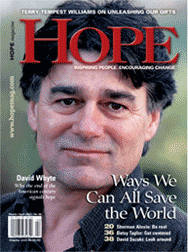Press
Signs of Hope - Adapted from Hope Magazine
| Adapted and updated from an article by William MacNeil in Hope Magazine, spring 1999.The elders honored by a New Mexico program are not your typical founding fathers. They're people like novelist Frank Waters and Apache artist Allan Houser, the creator of contemporary Indian sculpture. They're also people like "Motorcycle Mama" Winnie Beasley, who says "Life begins at sixty," and Gregorita Rodriguez, a traditional healer who raised nineteen children while working as a cleaning woman at a downtown hotel. They are farmers and preservationists, craftspeople and environmentalists, people who have contributed in all kinds of ways to improving their community. Under the Living Treasures program, these Santa Fe area elders are recognized at public ceremonies and receive certificates of award. Their photographs and interviews are archived at the local history library. The program, modeled after traditions from Japan as well as New Mexico's Native American and Hispanic communities, was started fifteen years ago by a group of peace activists. "We were tired of protest," explains activist and minister Mary Lou Cook. "We longed to be for something. We had in mind Gandhi's advice, ‘You must be the change you wish to see in the world.’" So the group decided to search out the people "who'd made this such a wonderful community," and simply thank them. As it happened, most of the people they found to thank were over seventy years, an age Cook refers to as "the civic generation." By honoring them, Cook and her group aim to inspire others to become civic-minded. But their intentions don't stop there. "One of our goals is to change the values of this culture," says Cook, who feels that society has "warehoused" elders rather than respecting their experience and using their potential. She says many people in our society ignore old people because of their own fears of aging, and believes the Living Treasures program could help change this thinking. In the early years, Living Treasures ceremonies were held in homes, but as its popularity grew, increased public attendance required the use of public spaces such as a library, meeting hall, or local museum. Usually two ceremonies are held each year, and usually three people receive official Living Treasures certificates. Sometimes an organization is honored for its work. In 1997, portraits and excerpts from the interviews of the first 104 Treasures were compiled into a book, Living Treasures: Celebration of the Human Spirit. Now word is out, and similar programs are springing up all over the state and across the country. Cook, who has appeared on national television and spoken with archivists at the Smithsonian, has written a sixteen page handbook, "How to Start a Living Treasures Program in Your Community," available for the asking. Cook recommends that the program be run by a group whose members have diverse backgrounds and experience as well as positive attitudes. Initial honorees may be selected from those known by the committee, but as the program becomes established, nominations come from the whole community. "The project is so simple and so magnificent," says Cook, who is now an official "Treasure" herself. "I give a great many talks," says Cook, "and invariably people come up to me and say, 'I always dreaded being old, but now I think it'll be fun.' We are models, and we're out there." |

